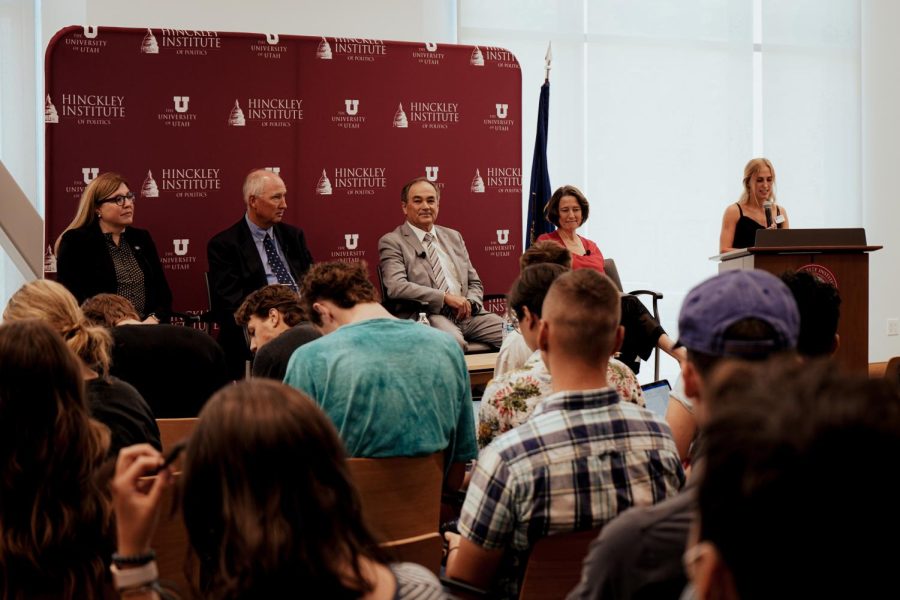Local Experts Discuss Great Salt Lake Drying Up, Emphasize Causes and Solutions
Local experts discusses possible solutions to save the Great Salt Lake at the Hinkley Institute of Politics on the University of Utah campus in Salt Lake City, Utah on Sept. 21, 2022. (Photo by Deylan Gudiel | The Daily Utah Chronicle)
September 23, 2022
Four panelists met at the Hinkley Institute of Politics on Wednesday, Sept. 21, to discuss the dire state of the Great Salt Lake. They answered questions from an audience weary of the drying lake’s impact on the environment and public health.
The panelists included Craig Buttars from the Utah Department of Agriculture, Dr. Kevin Perry, chair of the atmospheric sciences department at the U, Kim Shelly from the Utah Department of Environmental Quality and Dr. Bonnie Baxter, director of the Great Salt Lake Institute at Westminster College.
While their backgrounds and expertise varied, each member of the panel emphasized their personal connections with the Great Salt Lake.
“As I started going out to the lake for fieldwork I fell in love with the place,” Perry said. “It’s an absolutely incredible gem that is in serious danger of being unrecognizable.”
Perry has been studying the transport of dust particles, a topic that is particularly important in the case of the Great Salt Lake.
“As the lake was shrinking, we started seeing dust plumes come off the lake,” Perry said. “I immediately recognized the potential hazard associated with that.”
Baxter said the lake is 40% the capacity that it was 100 years ago and explained how we got to this point.
“The story as I see it is water diversions for our population upstream of the watershed have gotten us into this situation,” Baxter said. “It’s for housing, development, consumptive uses, agriculture, and now we’re not getting enough water trickling down to the bottom.”
Shelly said health concerns for citizens in the valley are a big worry caused by the shrinking of the Great Salt Lake.
“Dust in and of itself causes significant respiratory impacts, so it is a real concern across the state,” Shelly said. She added that the Department of Environmental Quality is also aware of toxic particles in the dust that might cause long-term health risks, including arsenic.
“Right now, the goal is to get water to the Great Salt Lake to minimize the drying lake bed that can be kicked up during a wind storm,” Shelly said.
The destruction of the lake’s ecosystem is a grave concern for Baxter as water levels drop.
“Seventeen percent [salinity] is too salty for the ecosystem, and at 16% we needed to sound the alarm,” Baxter said. “Now we’re above 18%. That’s terrifying to me.”
She also discussed the importance of the lake to migrating birds.
“Ten million birds come to this body of water to feed up before they migrate on,” Baxter said. “It’s probably the most important body of water for birds on the Pacific flyway.” She also explained the birds feed on brine flies in the lake, which are currently dying off by the billions due to rising salinity.
Despite the dire and fast-approaching consequences, all the panelists seemed optimistic about Utahns’ power to save the lake.
“We got into this situation by choices that we made on how we value water,” Perry said. “We can get ourselves out of this situation by altering that valuation and changing our relationship with water.”
Buttars highlighted some of what his department is doing to remedy the issue, including helping farmers optimize their water usage.
Utah legislators also allocated $250 million for secondary metering, which can help people keep track of the water they’re using to water their lawns, which isn’t something people are usually aware of. Secondary metering should fast-track water conservation efforts with the areas that have installed secondary meters seeing a reduction in water use by about 20-30%.
Buttars also emphasized the responsibility of individuals to do what they can to curb water consumption.
“We all need to turn inward and look at our expectations and do what we can to minimize our water usage,” Buttars said.








